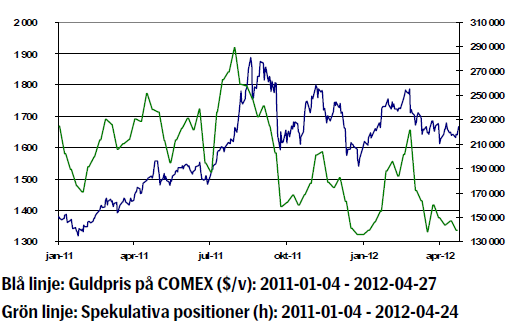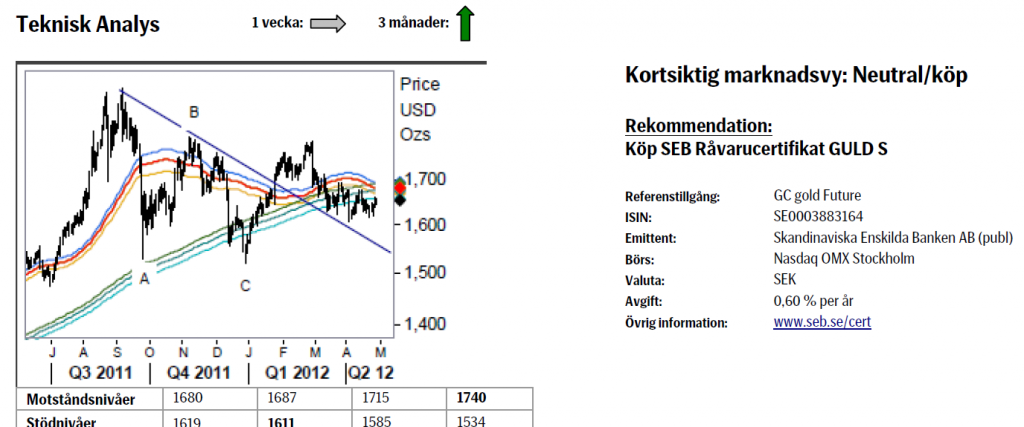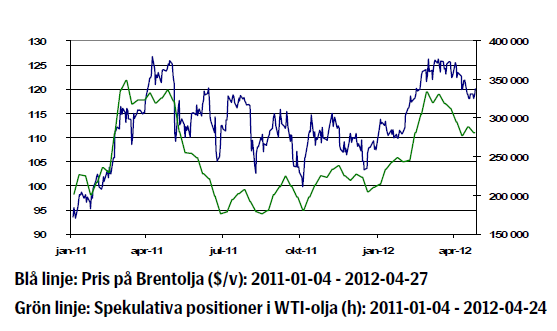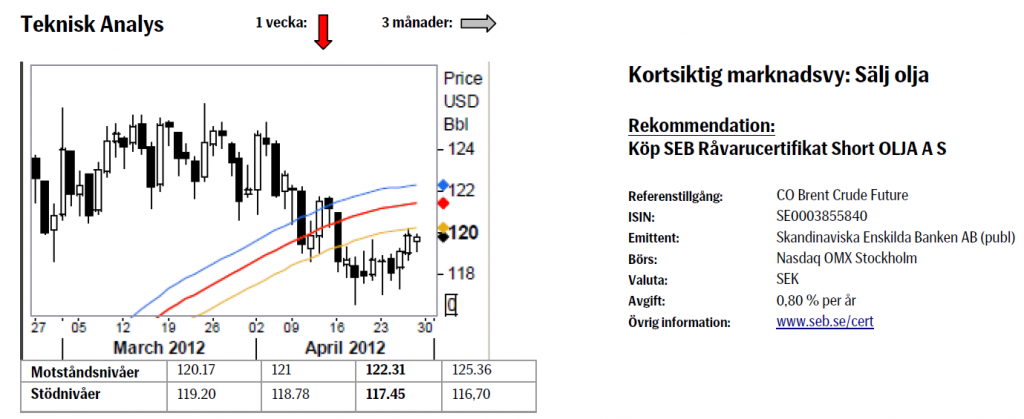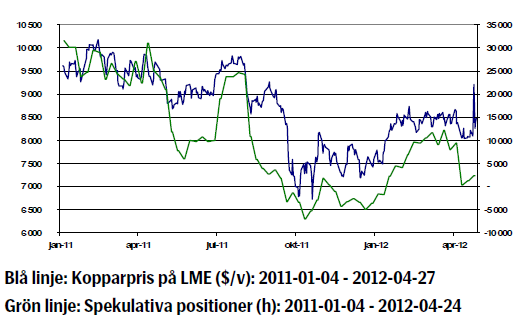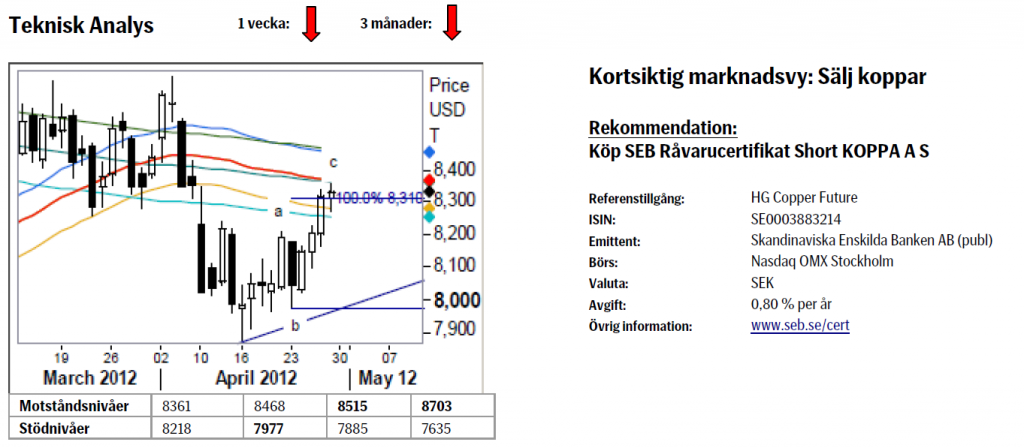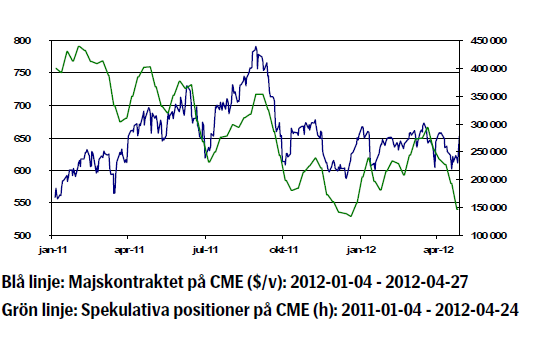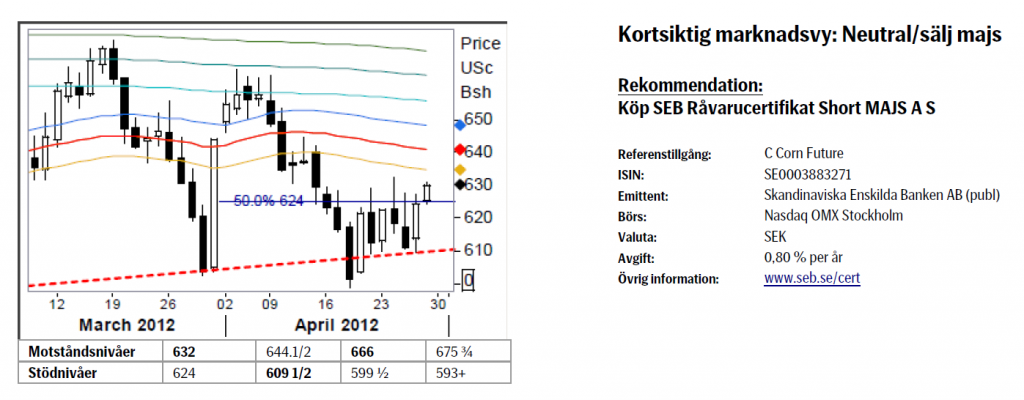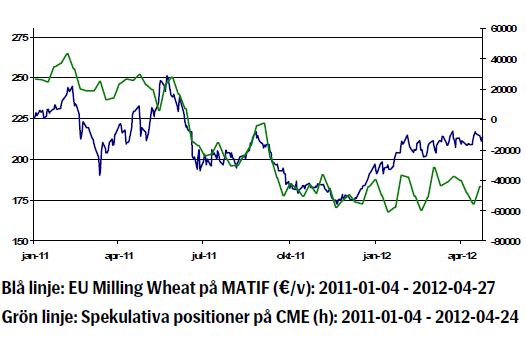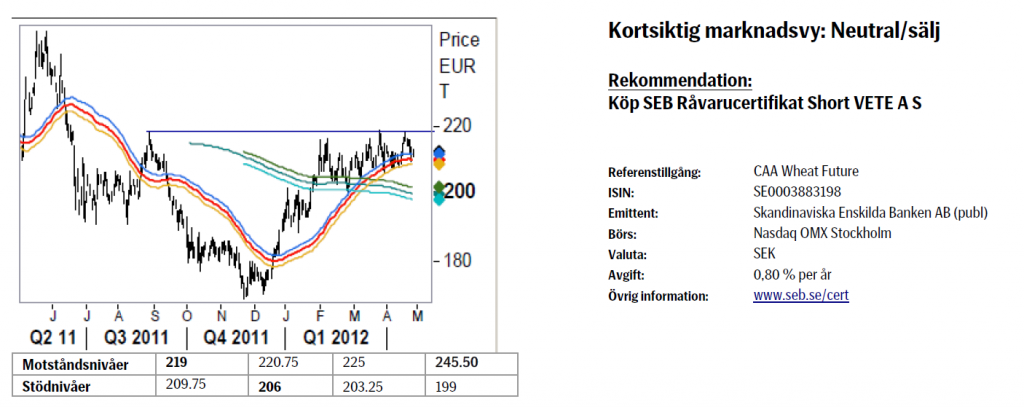Analys
SEB – Råvarukommentarer vecka 18 2012
Sammanfattning: Föregående vecka
 Brett råvaruindex: +1,62 %
Brett råvaruindex: +1,62 %
UBS Bloomberg CMCI TR Index- Energi: +1,42 %
UBS Bloomberg CMCI Energy TR Index - Ädelmetaller: +2,12 %
UBS Bloomberg CMCI Precious Metals TR Index - Industrimetaller: +3,47 %
UBS Bloomberg CMCI Industrial Metals TR Index - Jordbruk: +0,59 %
UBS Bloomberg CMCI Agriculture TR Index
Kortsiktig marknadsvy:
- Guld: Neutral/köp
- Olja: Sälj
- Koppar: Sälj
- Majs: Sälj
- Vete: Neutral/sälj
Guld
- Guldet steg 1,97 procent förra veckan och har för tillfället svårt att bryta ut på uppsidan. Flera länder går till val i Europa vilket försvårar för gemensamma förhandlingar. Tidigare överenskommelser såsom den förhandlade budgetpakten, som drivits fram av Tyskland, kan komma att rivas upp eller omförhandlas vilket försvagar euron och ger styrka till dollarn vilket i sin tur dämpar guldpriset.
- I USA redovisade U.S Mint guldmyntförsäljningen för april vilken var den lägsta på fem år. Endast 17 000 troy ounce (ett troy ounce är ca 31 gram) har sålts i april jämfört med 70 000 ton under årets tre första månader. Spekulativa positioner på Comex har också minskat.
- Fed lämnade räntan oförändrad vilket ger stöd åt guldpriset samtidigt som avsaknaden av ytterligare stimulanser verkade dämpande. Guldpriset var oför-ändrat på Feds räntebesked.
- Centralbanker är fortfarande nettoköpare av guld och den ryska centralbanken ökade sin reserv med 15,5 ton. Guldet kommer troligen från inhemsk produktion. Börsen i Shanghai kommer att införa högre marginalkrav för några råvaror, däribland guld. Höjningen träder i kraft den 27:e april. Detta kan tillfälligt förhindra prisökningar.
- Teknisk Analys: Dubbelbotten? Bara marginella rörelser noterade sedan förra fredagen. Dock har vi fått ett par spikar på nedsidan vilket visar att köparna har visat intresse under 1640 området något som vi tolkar lätt positivt. Som tidigare krävs dock åtminstone en uppgång över 1680 för att öka på sannolikheten för att en botten äntligen är på plats.
Olja
- Europa fortsätter att oroa marknaden och statistik från det viktiga dragloket Tyskland har varit sämre än förväntat. Preliminära inköpschefsindexet för den tyska industrin sjönk till 46,3 i april jämfört med 48,4 i mars. Det är den lägsta siffran på 33 månader. Att S & P:s beslutade att sänka Spaniens kreditbetyg två steg med fortsatt negativa utsikter spär på oro och ovisshet.
- Fed lämnade räntan oförändrad på onsdagen med en förväntad låg ränta t.o.m. slutet av 2014 eftersom de ekonomiska förhållandena enligt Fed kräver en extrem lågräntepolitik. Vad gäller kvantitativa lättnader så är Fed redo att göra mer om förhållanden i marknaden skulle kräva det. Oljepriset steg på beskedet att Fed trots allt reviderade upp sin prognos för amerikansk tillväxt i 2012.
- Förra veckan gjorde Iran ett utspel där landet meddelade att man kommer att överväga Rysslands förslag om att inte vidareutveckla landets kärnvapenprogram och att tillåta ytterligare inspektioner. Utspelet kan mycket väl vara ett sätt för landet att vinna tid. Oljan sjönk en procent efter uttalandet. Nytt atommöte med Iran kommer att hållas i Bagdad den 23:e maj.
- Veckostatistik från American Petroleum Institute (API) visade att råoljelager föll med en miljon fat medan onsdagens DOE siffra visade att råoljelager steg med fyra miljoner fat mot förväntade tre miljoner.
- Teknisk Analys: Återtest av bandet & sedan ned. Vi bör nu vara i slutfasen av återtestet av 55 dagars bandet (vi flaggade för förra veckan). Återtestet har gått långsammare än förväntat vilket å andra sidan visar på lågt deltagande av köpare, något som passar bra in i vår nu något mer negativ vy.
Koppar
- S & P:s beslutade i torsdags att sänka Spaniens kreditbetyg två steg med fort-satt negativa utsikter. Motiveringen är en ökad risk att spanska staten behöver mer kapital för att kunna bistå bankerna samt risk för två år med recession. Hela Eurozonen fick en känga av S & P: ”strategin att hantera Europas stats-skuldkris fortsätter att sakna effektivitet.” Euroländerna måste besluta om man ska hjälpa Spanien.
- Dollarn stärktes på S & Ps besked och kopparpriset steg t.o.m något trots dollarns förstärkning.
- Enligt kinesiska myndigheter importerade Kina 345,7 ton koppar i mars vilket är en minskning med 8 procent från februari. Flera rapporter bekräftar att koppar-lagren i Kina är välfyllda till bredden. Inkluderat 600 000 ton i frihamnslager uppges lagren uppgå till 1 miljon ton. Enligt estimat finns ¾ av globala lager i Kina nu. Marknaden i Kina är stängd idag.
- Terminskurvan i koppar är i backwardation dvs. framtida förväntade priser är billigare än aktuellt pris och denna skillnad blir allt större vilket vi tolkar som att tillgången på koppar utanför Kina är begränsad USA:s BNP ökade med 2,2 procent på årlig basis under det första kvartalet vilket var lägre än vad analytiker hade räknat med enligt Bloomberg. Siffran kan tolkas på så sätt att sannolikheten för kvantitativa lättnader ökar.
- Teknisk Analys: Färdig korrektion. Studsen upp från trend linjen blev lite starkare än vad vi initialt räknade med (8218) vilket i och för sig inte ändrar nå-got av den större vyn. Vi ser fortfarande marknaden som negativ och kommer att fortsätta göra så länge vi inte återetablerar oss över medelvärdesbanden.
Majs
- Majspriset steg ca en halv procent förra veckan. Vi kan se en fortsatt hög volatilitet i majsmarknaden, där majkontraktet i Chicago handlades upp och ned med några procent varje dag, men utan tydlig riktning.
- En faktor som hjälpt till att trycka upp priset är den kinesiska efterfrågan, där USDA i början av veckan kom ut med statistik som påvisade en god export av amerikansk majs till okända destinationer. Det kunde senare under veckan bekräftas att en stor del av denna majs gått till Kina.
- Samtidigt har det spekulerats en hel del kring huruvida den goda starten på den amerikanska majsplanteringen ska kunna fortsätta på samma sätt framöver, där det funnits en viss oro för att det kalla väder som råder norr om flera viktiga majsstater ska leta sig söderut. Då en mängd prognoser visat på att så inte är fallet har oron minskat och med dessa även efterfrågan på majs.
- Vi anser inte att förra veckans uppgång kan motiveras av stark efterfrågan från Kina och tror med detta att majspriset under den kommande veckan kommer att kunna falla tillbaka något.
- Teknisk Analys: Lite förvirrat. Efter det falska brottet under botten linjen samt efterföljande test och studs av densamma ser det ut som om marknaden skulle kunna vara på väg att söka sig norrut. Å andra sidan har vi än så länge inte lyckats hålla oss kvar över mitten punkten, 624, av den kraftigt stigande ”candlen” per 30:e mars. För att minska förvirringen måste vi bryta antingen 632 eller 609 ½.
Vete
- Vetet i Paris föll nära två procent veckan som gick. För närvarande är korrelationen mellan det amerikanska och det europeiska vetet mycket låg.
- I Europa är det en blandad utveckling med förhållandevis goda prognoser avseende veteskörden i Tyskland, Storbritannien och Frankrike. Samtidigt är förutsättningarna bedrövliga i Spanien, där man gång på gång tvingas justera ned sina produktionsestimat.
- I början av veckan kom International Grains Councils senaste spannmålsrapport, i vilken organisationen justerar ned sin prognos för den globala veteskörden. Denna nedrevidering av tidigare estimat är i princip uteslutande baserad på de europeiska köldproblemen från första kvartalet.
- Vi förhåller oss neutrala till svagt negativa till vetet i Paris denna vecka, där vi dock är beredda att snabbt positionera oss mot en nedgång om planteringssiffrorna fortsätter att överraska oss positivt i USA och Europa.
- Teknisk Analys: Tunga motstånd bromsar. Efter att i princip ha tangerat årshögsta faller vi tillbaka något i vad som får anses vara en mindre vinsthemtagning. Vidare behöver nog marknaden samla lite styrka för att kunna ta sig an ett så pass tungt motstånd som 219-området. Det mest troliga utfallet ser ut att bli intervall handel mellan medelvärdesbandet och topp området.
[box]SEB Veckobrev Veckans råvarukommentar är producerat av SEB Merchant Banking och publiceras i samarbete och med tillstånd på Råvarumarknaden.se[/box]
Disclaimer
The information in this document has been compiled by SEB Merchant Banking, a division within Skandinaviska Enskilda Banken AB (publ) (“SEB”).
Opinions contained in this report represent the bank’s present opinion only and are subject to change without notice. All information contained in this report has been compiled in good faith from sources believed to be reliable. However, no representation or warranty, expressed or implied, is made with respect to the completeness or accuracy of its contents and the information is not to be relied upon as authoritative. Anyone considering taking actions based upon the content of this document is urged to base his or her investment decisions upon such investigations as he or she deems necessary. This document is being provided as information only, and no specific actions are being solicited as a result of it; to the extent permitted by law, no liability whatsoever is accepted for any direct or consequential loss arising from use of this document or its contents.
About SEB
SEB is a public company incorporated in Stockholm, Sweden, with limited liability. It is a participant at major Nordic and other European Regulated Markets and Multilateral Trading Facilities (as well as some non-European equivalent markets) for trading in financial instruments, such as markets operated by NASDAQ OMX, NYSE Euronext, London Stock Exchange, Deutsche Börse, Swiss Exchanges, Turquoise and Chi-X. SEB is authorized and regulated by Finansinspektionen in Sweden; it is authorized and subject to limited regulation by the Financial Services Authority for the conduct of designated investment business in the UK, and is subject to the provisions of relevant regulators in all other jurisdictions where SEB conducts operations. SEB Merchant Banking. All rights reserved.
Analys
OPEC+ will likely unwind 500 kb/d of voluntary quotas in October. But a full unwind of 1.5 mb/d in one go could be in the cards

Down to mid-60ies as Iraq lifts production while Saudi may be tired of voluntary cut frugality. The Brent December contract dropped 1.6% yesterday to USD 66.03/b. This morning it is down another 0.3% to USD 65.8/b. The drop in the price came on the back of the combined news that Iraq has resumed 190 kb/d of production in Kurdistan with exports through Turkey while OPEC+ delegates send signals that the group will unwind the remaining 1.65 mb/d (less the 137 kb/d in October) of voluntary cuts at a pace of 500 kb/d per month pace.

Signals of accelerated unwind and Iraqi increase may be connected. Russia, Kazakhstan and Iraq were main offenders versus the voluntary quotas they had agreed to follow. Russia had a production ’debt’ (cumulative overproduction versus quota) of close to 90 mb in March this year while Kazakhstan had a ’debt’ of about 60 mb and the same for Iraq. This apparently made Saudi Arabia angry this spring. Why should Saudi Arabia hold back if the other voluntary cutters were just freeriding? Thus the sudden rapid unwinding of voluntary cuts. That is at least one angle of explanations for the accelerated unwinding.
If the offenders with production debts then refrained from lifting production as the voluntary cuts were rapidly unwinded, then they could ’pay back’ their ’debts’ as they would under-produce versus the new and steadily higher quotas.
Forget about Kazakhstan. Its production was just too far above the quotas with no hope that the country would hold back production due to cross-ownership of oil assets by international oil companies. But Russia and Iraq should be able to do it.
Iraqi cumulative overproduction versus quotas could reach 85-90 mb in October. Iraq has however steadily continued to overproduce by 3-5 mb per month. In July its new and gradually higher quota came close to equal with a cumulative overproduction of only 0.6 mb that month. In August again however its production had an overshoot of 100 kb/d or 3.1 mb for the month. Its cumulative production debt had then risen to close to 80 mb. We don’t know for September yet. But looking at October we now know that its production will likely average close to 4.5 mb/d due to the revival of 190 kb/d of production in Kurdistan. Its quota however will only be 4.24 mb/d. Its overproduction in October will thus likely be around 250 kb/d above its quota with its production debt rising another 7-8 mb to a total of close to 90 mb.
Again, why should Saudi Arabia be frugal while Iraq is freeriding. Better to get rid of the voluntary quotas as quickly as possible and then start all over with clean sheets.
Unwinding the remaining 1.513 mb/d in one go in October? If OPEC+ unwinds the remaining 1.513 mb/d of voluntary cuts in one big go in October, then Iraq’s quota will be around 4.4 mb/d for October versus its likely production of close to 4.5 mb/d for the coming month..
OPEC+ should thus unwind the remaining 1.513 mb/d (1.65 – 0.137 mb/d) in one go for October in order for the quota of Iraq to be able to keep track with Iraq’s actual production increase.
October 5 will show how it plays out. But a quota unwind of at least 500 kb/d for Oct seems likely. An overall increase of at least 500 kb/d in the voluntary quota for October looks likely. But it could be the whole 1.513 mb/d in one go. If the increase in the quota is ’only’ 500 kb/d then Iraqi cumulative production will still rise by 5.7 mb to a total of 85 mb in October.
Iraqi production debt versus quotas will likely rise by 5.7 mb in October if OPEC+ only lifts the overall quota by 500 kb/d in October. Here assuming historical production debt did not rise in September. That Iraq lifts its production by 190 kb/d in October to 4.47 mb/d (August level + 190 kb/d) and that OPEC+ unwinds 500 kb/d of the remining quotas in October when they decide on this on 5 October.

Analys
Modest draws, flat demand, and diesel back in focus

U.S. commercial crude inventories posted a marginal draw last week, falling by 0.6 million barrels to 414.8 million barrels. Inventories remain 4% below the five-year seasonal average, but the draw is far smaller than last week’s massive 9.3-million-barrel decline. Higher crude imports (+803,000 bl d WoW) and steady refinery runs (93% utilization) helped keep the crude balance relatively neutral.

Yet another drawdown indicates commercial crude inventories continue to trend below the 2015–2022 seasonal norm (~440 million barrels), though at 414.8 million barrels, levels are now almost exactly in line with both the 2023 and 2024 trajectory, suggesting stable YoY conditions (see page 3 attached).
Gasoline inventories dropped by 1.1 million barrels and are now 2% below the five-year average. The decline was broad-based, with both finished gasoline and blending components falling, indicating lower output and resilient end-user demand as we enter the shoulder season post-summer (see page 6 attached).
On the diesel side, distillate inventories declined by 1.7 million barrels, snapping a two-week streak of strong builds. At 125 million barrels, diesel inventories are once again 8% below the five-year average and trending near the low end of the historical range.
In total, commercial petroleum inventories (excl. SPR) slipped by 0.5 million barrels on the week to ish 1,281.5 million barrels. While essentially flat, this ends a two-week streak of meaningful builds, reflecting a return to a slightly tighter situation.
On the demand side, the DOE’s ‘products supplied’ metric (see page 6 attached), a proxy for implied consumption, softened slightly. Total demand for crude oil over the past four weeks averaged 20.5 million barrels per day, up just 0.9% YoY.
Summing up: This week’s report shows a re-tightening in diesel supply and modest draws across the board, while demand growth is beginning to flatten. Inventories remain structurally low, but the tone is less bullish than in recent weeks.


Analys
Are Ukraine’s attacks on Russian energy infrastructure working?

Brent crude rose 1.6% yesterday. After trading in a range of USD 66.1 – 68.09/b it settled at USD 67.63/b. A level which we are well accustomed to see Brent crude flipping around since late August. This morning it is trading 0.5% higher at USD 68/b. The market was expecting an increase of 230 kb/d in Iraqi crude exports from Kurdistan through Turkey to the Cheyhan port but that has so far failed to materialize. This probably helped to drive Brent crude higher yesterday. Indications last evening that US crude oil inventories likely fell 3.8 mb last week (indicative numbers by API) probably also added some strength to Brent crude late in the session. The market continues to await the much heralded global surplus materializing as rising crude and product inventories in OECD countries in general and the US specifically.

The oil market is starting to focus increasingly on the successful Ukrainian attacks on Russian oil infrastructure. Especially the attacks on Russian refineries. Refineries are highly complex and much harder to repair than simple crude oil facilities like export pipelines, ports and hubs. It can take months and months to repair complex refineries. It is thus mainly Russian oil products which will be hurt by this. First oil product exports will go down, thereafter Russia will have to ration oil product consumption domestically. Russian crude exports may not be hurt as much. Its crude exports could actually go up as its capacity to process crude goes down. SEB’s Emerging Market strategist Erik Meyersson wrote about the Ukrainian campaign this morning: ”Are Ukraine’s attacks on Russian energy infrastructure working?”. Phillips P O’Brian published an interesting not on this as well yesterday: ”An Update On The Ukrainian Campaign Against Russian Refineries”. It is a pay-for article, but it is well worth reading. Amongst other things it highlights the strategic focus of Ukraine towards Russia’s energy infrastructure. A Ukrainian on the matter also put out a visual representation of the attacks on twitter. We have not verified the data representation. It needs to be interpreted with caution in terms of magnitude of impact and current outage.
Complex Russian oil refineries are sitting ducks in the new, modern long-range drone war. Ukraine is building a range of new weapons as well according to O’Brian. The problem with attacks on Russian refineries is thus on the rise. This will likely be an escalating problem for Russia. And oil products around the world may rise versus the crude oil price while the crude oil price itself may not rise all that much due to this.
Russian clean oil product exports as presented by SEB’s Erik Meyersson in his note this morning.
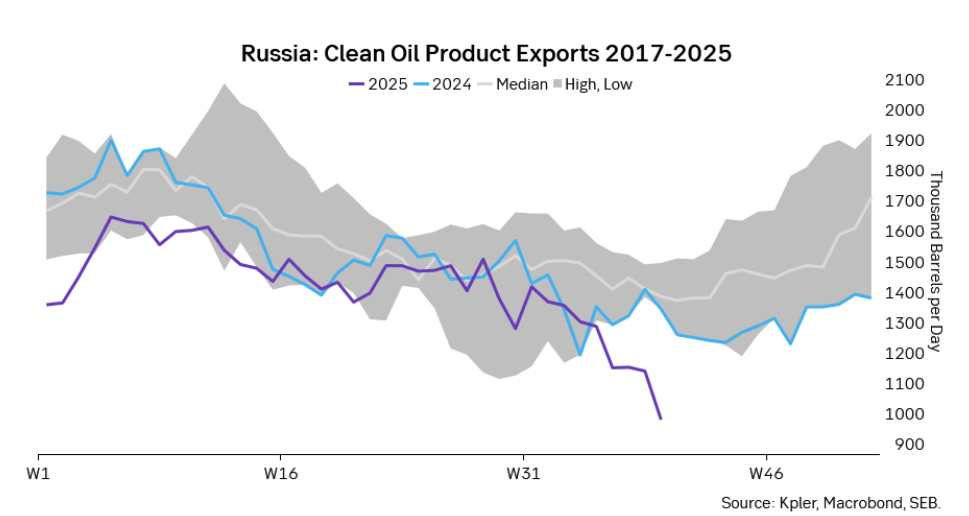
The ICE Gasoil crack and the 3.5% fuel oil crack has been strengthening. The 3.5% crack should have weakened along with rising exports of sour crude from OPEC+, but it hasn’t. Rather it has moved higher instead. The higher cracks could in part be due to the Ukrainian attacks on Russian oil refineries.
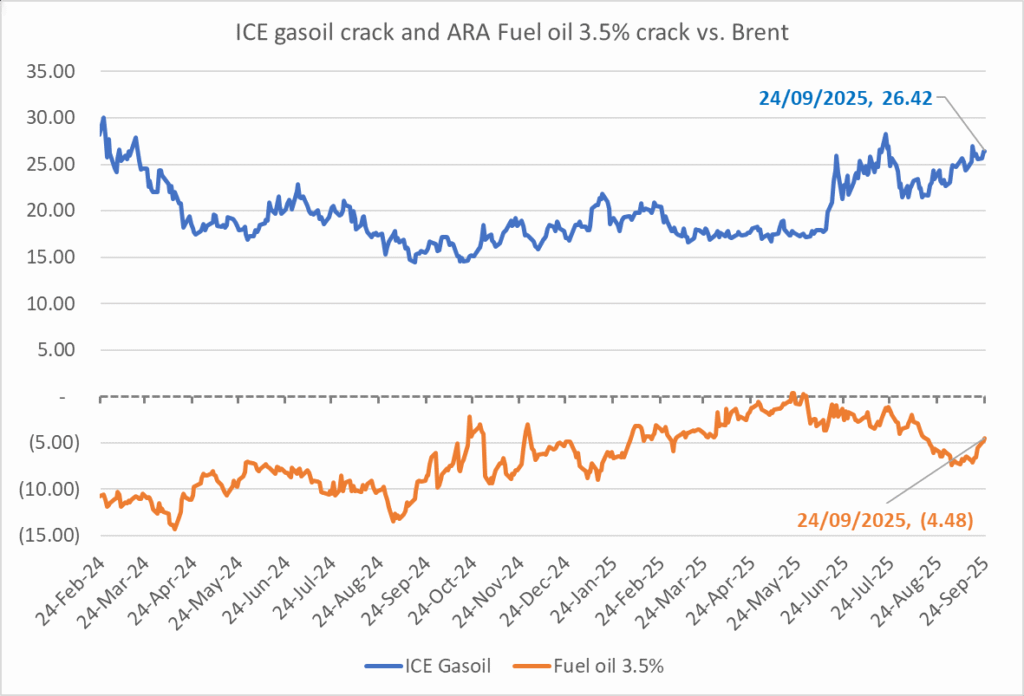
Ukrainian inhabitants graphical representation of Ukrainian attacks on Russian oil refineries on Twitter. Highlighting date of attacks, size of refineries and distance from Ukraine. We have not verified the detailed information. And you cannot derive the amount of outage as a consequence of this.

-

 Nyheter4 veckor sedan
Nyheter4 veckor sedanEurobattery Minerals satsar på kritiska metaller för Europas självförsörjning
-

 Nyheter3 veckor sedan
Nyheter3 veckor sedanMahvie Minerals i en guldtrend
-

 Nyheter4 veckor sedan
Nyheter4 veckor sedanGuldpriset kan närma sig 5000 USD om centralbankens oberoende skadas
-

 Nyheter4 veckor sedan
Nyheter4 veckor sedanOPEC signalerar att de inte bryr sig om oljepriset faller kommande månader
-

 Analys3 veckor sedan
Analys3 veckor sedanVolatile but going nowhere. Brent crude circles USD 66 as market weighs surplus vs risk
-

 Nyheter3 veckor sedan
Nyheter3 veckor sedanAktier i guldbolag laggar priset på guld
-

 Nyheter3 veckor sedan
Nyheter3 veckor sedanKinas elproduktion slog nytt rekord i augusti, vilket även kolkraft gjorde
-

 Nyheter2 veckor sedan
Nyheter2 veckor sedanTyskland har så höga elpriser att företag inte har råd att använda elektricitet


